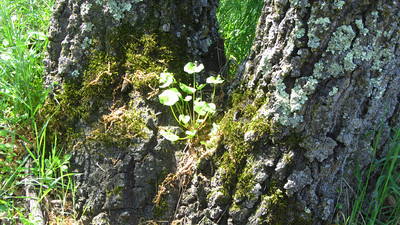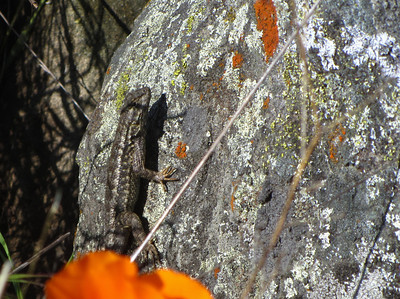Lichen
Lichens are all around you and are some of the most interesting plants in the Open Space. They grow on rocks, tree trunks and branches. They don't live on leaves because more time than one growing season is needed to establish themselves. In the Rocky Mountains, for example, the growth rate of lichens has been estimated at one inch per century.
Lichen's lead the way for moss and other plants to grow on this tree trunk
Symbiosis
The most interesting thing about lichens is that they actually consist of two different kinds of living things - an alga and a fungus. Lichen, therefore, is really a compound creature. This association is called "symbiosis." The fungus is a network of small fungal root-hairs (called "hyphae") that mechanically protects the algae which, in turn, produces carbohydrates, organic nitrogen and vitamins, thus providing the fungus with growth materials. In this manner, both organisms benefit.In fact, scientists have attempted to separate the lichen fungi and algae and then tried to grow them on their own. It didn't work. Neither could grow without the other.

Lizard hanging out on a lichen covered rock
A community of lichens
Note the large rock at the road junctions on the Fossil Hill Nature Walk. There is almost no bare rock. Lichens of different colors cover virtually all of this rock. Each color indicates a slightly different species of lichens.Lichens eventually die and, when they do, their decomposition creates a weak solution of carbonic acid that eats into the rock. This "rock dust" mixed with other organic materials makes a thin soil where mosses can grow. Mosses, in turn, provide a base for grasses and other small plants. Eventually there is enough soil for bushes and trees to get a toe hold. In this manner, with time, rocky outcrops turn into soil and become forests. Lichen, therefore, are "pioneer" plants that start the process of breaking down rocks to produce soil.
Jerry Fritzke
March 1, 2003




 Join/Renew
Join/Renew Donate
Donate Volunteer
Volunteer Maps
Maps Newsletter
Newsletter Facebook
Facebook
